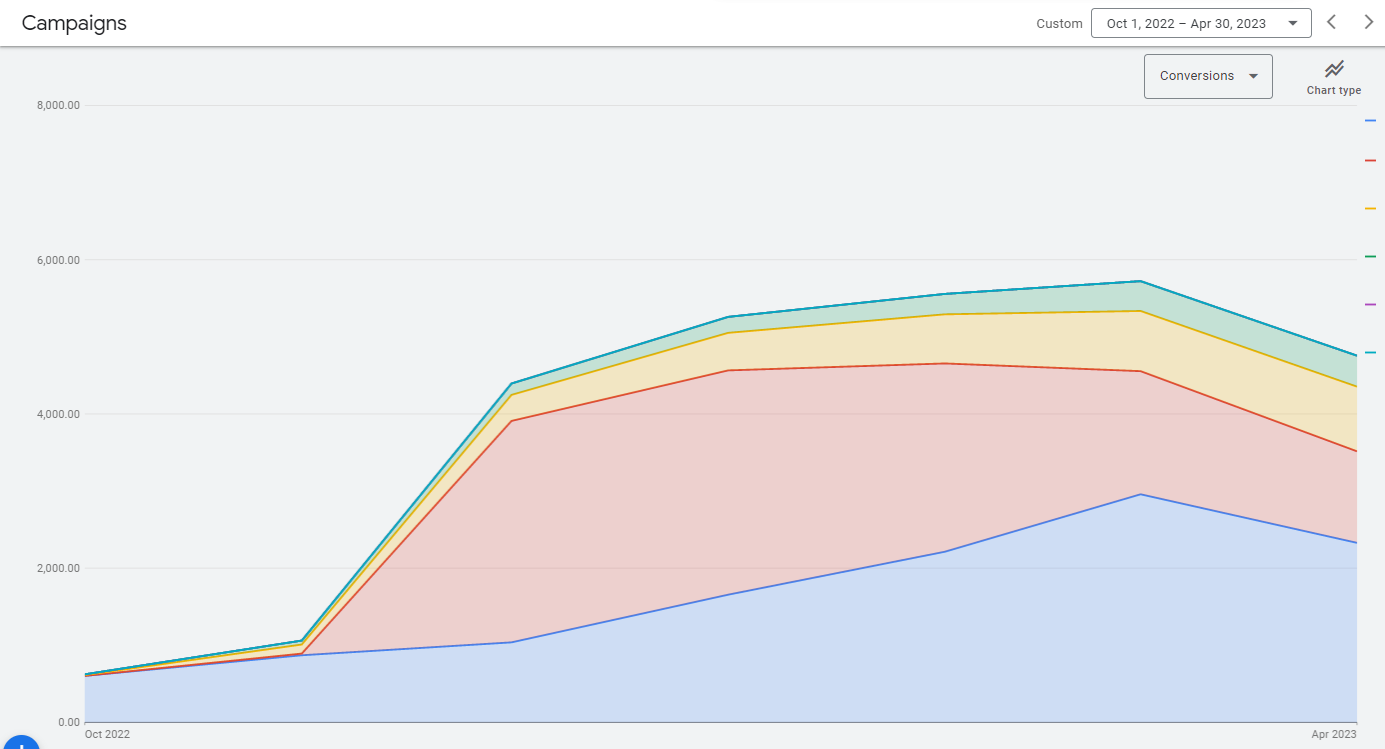Project Overview:
- Client: A major forex broker
- Campaign Duration: October 1, 2022, to April 30, 2023
- Target Geographies: Tier 1 and Tier 2 countries
- Ad Spend: $250,000 on search, display, and performance-maximized campaigns
- Primary Goals: Reduce CPL, increase the number of deposits, and improve ROAS.
Starting Metrics (October 1, 2022):
- CPL: $16
- Cost per user with a deposit: $83
- Average ROAS: 8
- Conversion Rate (CR) into leads: 2.5%
Final Metrics (April 30, 2023):
- CPL: $10
- Cost per user with a deposit: $54
- Average ROAS: 15
- Conversion Rate (CR) into leads: 3.3%

Key Steps and Achievements
Optimization of Keywords and AD Creatives
We conducted a detailed analysis of keywords and ad creatives to optimize the campaign’s performance, resulting in significant improvements in click-through rates (CTR) and conversion rates. Here are the key actions taken:
-
Keyword Research and Selection:
- Extensive research was conducted to identify relevant keywords with high search volumes and low competition.
- A comprehensive list of target keywords was generated, including broad and long-tail ones.
- High-performing keywords were prioritized based on their potential to drive quality traffic and conversions.
-
Ad Copy Enhancement:
- Ad copy variations were created to test different messaging approaches and optimize ad performance.
- Compelling and persuasive ad headlines and descriptions were crafted to attract the target audience.
- Keyword insertion techniques were used to match the user’s search query dynamically with ad text, increasing relevance.
-
Ad Extensions Implementation:
- Sitelink extensions, call extensions, and structured snippet extensions were utilized to provide additional information and enhance the ad’s visibility.
- Ad extensions proved effective in driving higher CTRs and improving the overall ad quality.

Results:
- CTR increased by 25% after implementing optimized ad creatives and leveraging relevant keywords.
- Conversion rates saw a significant boost, with a 32% improvement compared to the initial stage of the campaign.
- The implementation of ad extensions contributed to a 15% increase in click-through rates for ads featuring those extensions.
These optimizations improved ad relevance and alignment with user search queries, resulting in higher engagement and increased chances of converting leads into depositing customers.
We continued monitoring and regular adjustments to keyword bids, ad copy, and extensions allowed for ongoing optimization, ensuring that the campaign remained effective throughout its duration.
Overall, the strategic optimization of keywords and ad creatives resulted in improved campaign performance, higher CTRs, and increased conversion rates, contributing to achieving the project’s goals.
Improvement of Traffic Quality and Conversions
Several targeted strategies were implemented to enhance the quality of traffic and increase conversions. Here are the key actions taken:
-
Landing Page Optimization:
- Thorough analysis of landing pages was conducted to identify areas for improvement.
- Page load speed was optimized to ensure a seamless user experience and reduce bounce rates.
- Clear and compelling call-to-action (CTA) elements were added to encourage visitors to take the desired action.
- A/B testing evaluated different landing page variations and identified the most effective design and content elements.
-
Audience Targeting Refinement:
- Target audience segments were reviewed and refined to focus on high-value prospects.
- Demographic data, such as age, gender, and location, were analyzed to identify the most responsive segments.
- Custom audience lists were created based on user behavior and engagement with previous campaigns.
- Remarketing campaigns were launched to re-engage with users who had previously shown interest but had not converted.
-
Ad Placement Optimization:
- Display network placements were analyzed to identify high-performing websites and placements.
- Poor-performing placements were excluded to minimize wasted ad spend.
- Contextual targeting was implemented to ensure ads were displayed on relevant websites and content.
- Managed placements were utilized to target websites or apps deemed highly relevant to the target audience.

Results:
- Conversion rates saw a significant improvement of 32%, indicating a higher number of visitors taking the desired actions.
- The bounce rate decreased by 18% after implementing landing page optimizations, indicating improved user engagement and website relevance.
- Remarketing campaigns achieved a 28% increase in conversion rates compared to previous campaigns, demonstrating the effectiveness of targeting previous site visitors.
These traffic quality and conversion optimization efforts resulted in a more engaged and responsive audience, leading to a higher number of deposits and increased revenue for the forex broker.
Continued monitoring of website analytics and user behavior allowed for ongoing refinements and optimizations, ensuring the campaign’s effectiveness and maximizing return on investment.
Cost Optimization and Increased ROI
Various strategies were employed to optimize costs and improve the campaign’s return on investment (ROI). These initiatives aimed to reduce the cost per lead and cost per user with a deposit while maximizing revenue generated. Here are the key actions taken:
-
Continuous Monitoring and Data Analysis:
- Regular monitoring of campaign performance metrics, such as cost per click (CPC), conversion rates, and cost per acquisition (CPA), allowed for data-driven decision-making.
- Key performance indicators (KPIs) were tracked and analyzed to identify underperforming areas and opportunities for improvement.
- Conversion tracking and attribution models were used to measure the impact of different marketing channels and campaigns on the final conversion results.
-
Bid and Budget Optimization:
- Bid adjustments were made based on the performance of individual keywords, ad groups, and placements.
- Budget allocations were optimized to allocate more resources to high-performing campaigns and channels while reducing spending on less effective ones.
- Automated bidding strategies, such as target CPA or target ROAS, were implemented to dynamically optimize bids based on predefined goals and performance thresholds.
-
Campaign Refinement and Testing:
- Ad variations were tested to identify the most effective combinations of ad copy, headlines, and CTAs.
- Ad scheduling was adjusted to target peak performance hours and days, maximizing ad exposure during periods of high user activity and engagement.
- Ad placement exclusions were used to avoid displaying ads on irrelevant or low-converting websites or placements.
- Results:
- The cost per lead (CPL) decreased from $16 to $10, indicating a 37.5% reduction in the cost of acquiring a potential customer.
- The cost per user with a deposit improved from $83 to $54, representing a 35% decrease in acquisition costs.
- The average return on ad spend (ROAS) increased from 8 to 15, indicating that for every dollar invested in advertising, $15 in revenue was generated.
These cost optimization strategies improved the campaign’s efficiency and cost-effectiveness, allowing the forex broker to achieve a higher ROI.By reducing acquisition costs and increasing revenue generated from users with deposits, the campaign demonstrated its ability to attract and convert high-quality leads.
Ongoing monitoring and optimization efforts ensured that the campaign remained cost-effective and aligned with the project’s goals throughout its duration.
In conclusion, the diligent cost optimization measures, including continuous monitoring, bid and budget adjustments, and campaign refinements, contributed to a substantial reduction in acquisition costs and an increased return on investment for the forex broker.
Results:
- CPL decreased from $16 to $10, reducing the cost of acquiring a potential customer and lowering marketing expenses.
- Cost per user with a deposit improved from $83 to $54, indicating an increase in average revenue generated per new user, a crucial indicator of campaign financial effectiveness.
- Average ROAS increased from 8 to 15, indicating that every dollar invested in advertising resulted in 15 times more revenue. This high ROAS demonstrates the campaign’s ability to attract quality traffic.
- CR into leads improved from 2.5% to 3.3%, indicating more potential clients expressing interest in the forex broker’s offering and taking action, such as providing contact information or registering.
Conclusions and Recommendations
- Following the successful launch and optimization of the advertising campaigns, it is recommended to continue monitoring and optimizing the campaigns to maintain and further improve CPL, cost per user with a deposit, ROAS, and CR into leads.
- Expanding the campaign’s geographical targeting to other markets or countries may present potential opportunities for acquiring new clients and increasing deposit volumes.
- Utilizing various ad formats, such as remarketing, YouTube advertising, or mobile app advertising, can help broaden the audience reach and diversify advertising channels.
- Regular competitor analysis and monitoring industry trends in the forex broker market will help stay ahead of the competition and adapt advertising strategies for optimal performance.

 Amazon Marketing
Amazon Marketing


